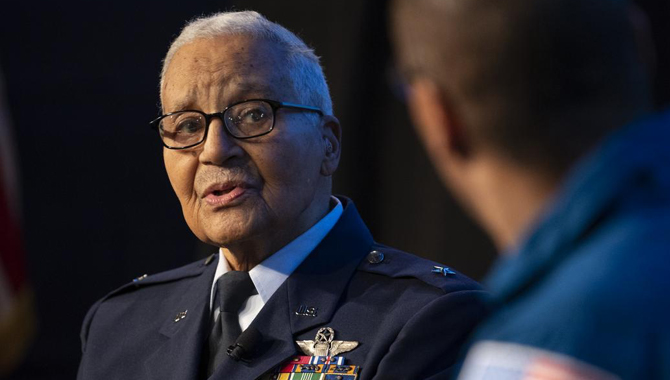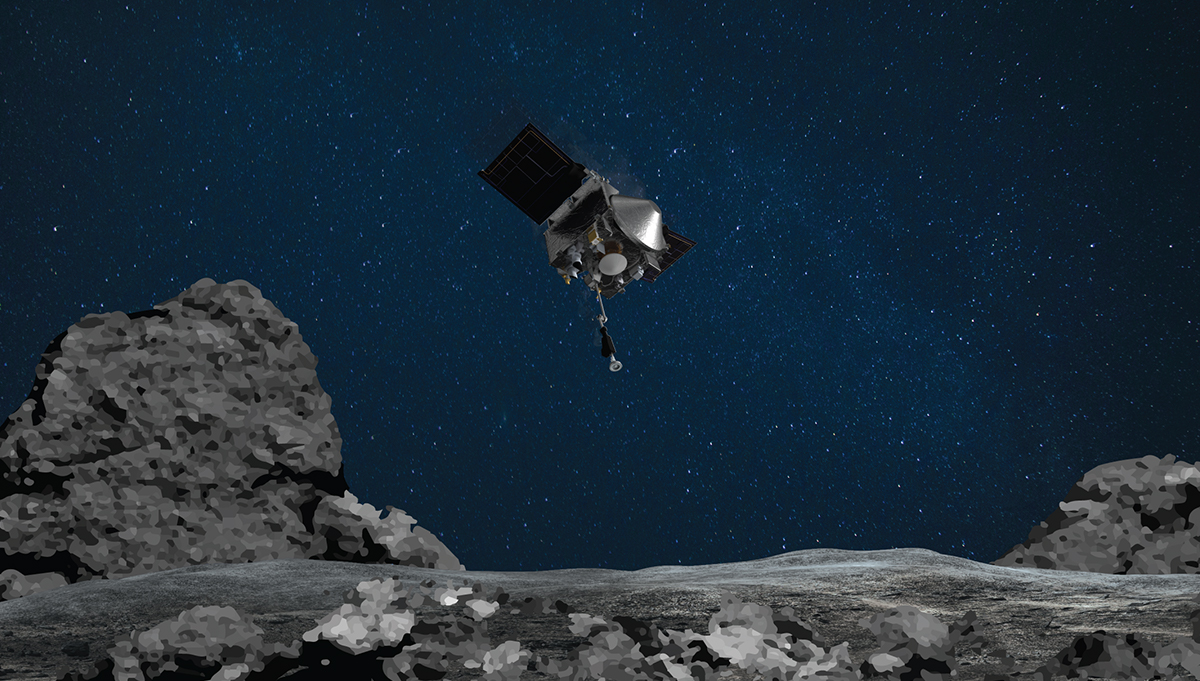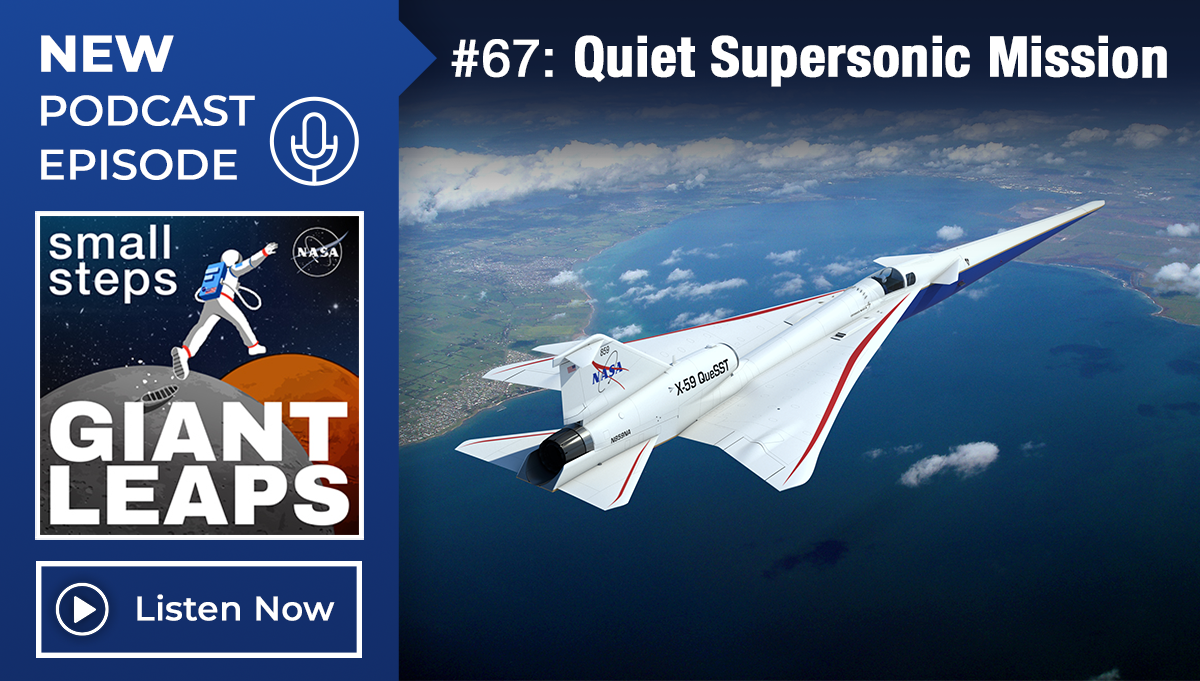
Retired U.S. Air Force Honorary Brigadier General Charles McGee speaks with NASA astronaut Alvin Drew during a Black History Month program titled “Trailblazers, The Story of a Tuskegee Airman.”
Credit: NASA/Joel Kowsky
Brigadier General Charles E. McGee discusses his career as an aviation trailblazer.
When Brigadier General Charles E. McGee took the controls of a Boeing PT-17 Stearman airplane for the first time in Tuskegee, Alabama, he was hooked. That 1942 training flight began a lifetime love of flying that has extended beyond his 100th birthday and a distinguished career as a military aviator that helped change the world.
NASA recently honored McGee, a member of the famed Tuskegee Airmen, at a ceremony sponsored by the NASA Headquarters chapter of Blacks in Government as part of Black History Month. McGee discussed his career as an aviation trailblazer, from his arrival at Tuskegee through the integration of the U.S. military, with NASA astronaut Alvin Drew, a space shuttle veteran who has spent 612 hours in space.
“Here you are, this midwestern boy, comfortably north of the Mason-Dixon line, and you’re about to head into the darkest depths of the deep south, where Jim Crow is alive and well. What were you thinking?” Drew asked.
McGee responded that he hadn’t allowed himself to dwell on that aspect of the experience before him and that he and his classmates relied on other classmates familiar with the south at that time to keep them safe. “That didn’t deter from the training that we got, and that was what was key.”

Retired U.S. Air Force Honorary Brigadier General Charles McGee, left, speaks with NASA astronaut Alvin Drew during a Black History Month program titled “Trailblazers, The Story of a Tuskegee Airman,” Wednesday, Feb. 5, 2020, at NASA Headquarters in Washington, DC.
Credit: NASA/Joel Kowsky
“All I can say is when I finally got called south, got that first ride, I was hooked,” McGee said. “I love flying and to be able to get off the ground and loop, roll and spin and come back and put your feet on the ground—that’s for me!”
The culmination of months of hard work in Tuskegee came on June 30, 1943, when “they pinned on those silver wings, and training was also as an officer, so became a second lieutenant. So, gold bars and silver wings—we were in hog heaven,” McGee recalled with a laugh. Advanced training in Michigan later focused on weapons and tactical maneuvers.
McGee went to Europe, where he began flying the Bell P-39 Airacobra over Italy as part of the 332nd Fighter Group. The P-39 was a fighter with a single Allison V-12 engine mounted behind the cockpit in the center of the plane. The fighters were fitted with a T9 cannon and two Browning .50 caliber machine guns.
The planes were not effective interceptors, however, and the group was switched to the Republic P-47 Thunderbolts, which use a 2,000 hp Pratt & Whitney XR-2800-21 engine and carry eight 0.50 caliber machine guns, four on each wing.
Although twice as heavy as many fighter planes in the air at that time, the P-47s could accelerate exceptionally fast during a dive, reaching speeds of 725 miles per hour. Coupled with its .50 caliber guns, which could fire a collective 100 rounds per second, the plane was a formidable mainstay throughout the war. The 332nd group became known as the “Red Tails,” because the tails of the planes were painted bright red. This enabled U.S. pilots flying the B-24 Liberator and Boeing B-17 Flying Fortress bombers that the 332nd were accompanying to immediately see that the fighters were friendly forces.
“Fortunately, somebody at 15th Air Force realized that bomber crews need to know that these aircraft suddenly showing up are friendly, not German,” McGee said. “Some of the bomb groups, not knowing red tails were black pilots, but said by request, ‘If [they could] get the Red Tails, they were happy.’ ”
McGee flew 137 combat missions during World War II before returning to Tuskegee Army Airfield at the end of 1944 to serve as a flight instructor. He flew a total of 409 combat missions in his military career, which spanned World War II, the Korean War and the Vietnam War. McGee, who is in the National Aviation Hall of Fame, has earned the Distinguished Flying Cross, Legion of Merit and Bronze Star. Then president George W. Bush presented the Congressional Gold Medal to the Tuskegee Airmen in 2007. He was recently promoted to Brigadier General by President Donald Trump.
NASA presented McGee with a framed print, that includes official space shuttle program pins made from metal flown aboard a space shuttle mission, as well as a U.S. flag and an Ohio state flag that were flown to the International Space Station aboard the final shuttle mission.
“NASA is presenting this to you in honor of the courage, the leadership, and innovation that you have consistently demonstrated throughout a lifetime of achievement in the field of aviation, for the inspiration that you provide to the next generation of air and space travelers, and for your service to our nation. We offer our deepest gratitude from the National Aeronautics and Space Administration, February 2020,” said Melanie Saunders, Deputy Associate Administrator.
McGee, who has marked both his 99th and 100th birthdays at the co-pilot controls of an airplane, flying, finished by requesting that members of the audience become mentors.
“Whether it’s in your family, in your neighborhood, or in the city, there are youngsters needing that. Somewhere in your neighborhood there is one in need. If you aren’t mentoring a youngster, find one, because they are out there, and they are in need and they are the future of our country,” McGee said.









